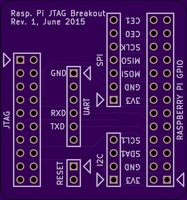Breaks out the Raspberry Pi (A or B, Rev. 2) GPIO header to an
ARM 20 JTAG
header. It will also work with Raspberry Pi A+
and B+, so long as you take care of the 26 to 40 pin conversion.
I imagine it will a…
Breaks out the Raspberry Pi (A or B, Rev. 2) GPIO header to an
ARM 20 JTAG
header. It will also work with Raspberry Pi A+
and B+, so long as you take care of the 26 to 40 pin conversion.
I imagine it will also work with the Raspberry Pi 2, but I’ve not
tried it out.
This is for debug access to the ARM core of the Broadcom chip,
not the Video IV core.
I use an Olimex ARM-USB-OCD-H JTAG
but this should work well enough with any standard ARM 20 JTAG debugger.
Note that the DBGRQ and DBGACK pins are unconnected.
There is no pin on the GPIO header to initiate a system reset.
Raspberry Pi boards have an unpopulated header (called P6 on Rev. 2 A and B boards,
called Run on later boards). Solder in a 2 pin length of breakaway,
and connect to the reset header on the JTAG breakout. Connect pin 1 to pin1, pin 2 to pin2.
Then the JTAG adapter will be able to initiate a system reset.
The pins are not configured for JTAG by default at system reset.
The pins are GPIO pins that have to be configured to alternate
functions by software at boot time. For an example,see
the armjtag project
by David Welch.
The layout of the UART serial port breakout is the same as the
Beaglebone Black, This is convenient
for connecting USB to TTL serial adapters, such as the FTDI Friend
or the FTDI Basic.
Like the Beaglebone Black, pins 2, 3 and 6 of the UART header are
unconnected.

